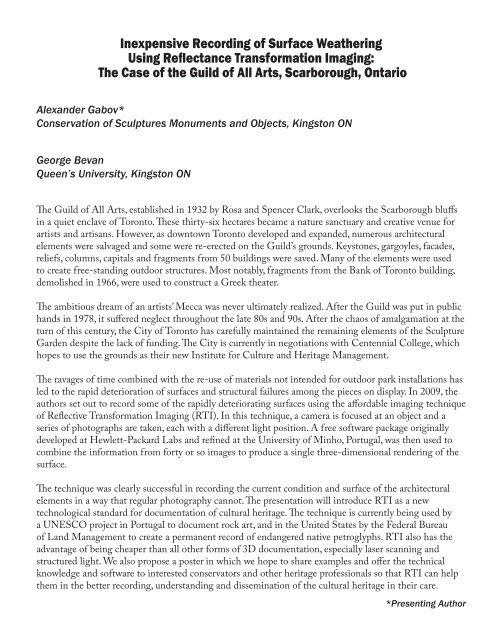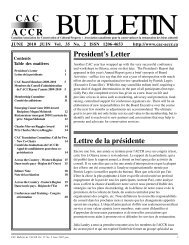Ottawa - Canadian Association for Conservation
Ottawa - Canadian Association for Conservation
Ottawa - Canadian Association for Conservation
You also want an ePaper? Increase the reach of your titles
YUMPU automatically turns print PDFs into web optimized ePapers that Google loves.
Inexpensive Recording of Surface Weathering<br />
Using Reflectance Trans<strong>for</strong>mation Imaging:<br />
The Case of the Guild of All Arts, Scarborough, Ontario<br />
Alexander Gabov*<br />
<strong>Conservation</strong> of Sculptures Monuments and Objects, Kingston ON<br />
George Bevan<br />
Queen’s University, Kingston ON<br />
The Guild of All Arts, established in 1932 by Rosa and Spencer Clark, overlooks the Scarborough bluffs<br />
in a quiet enclave of Toronto. These thirty-six hectares became a nature sanctuary and creative venue <strong>for</strong><br />
artists and artisans. However, as downtown Toronto developed and expanded, numerous architectural<br />
elements were salvaged and some were re-erected on the Guild’s grounds. Keystones, gargoyles, facades,<br />
reliefs, columns, capitals and fragments from 50 buildings were saved. Many of the elements were used<br />
to create free-standing outdoor structures. Most notably, fragments from the Bank of Toronto building,<br />
demolished in 1966, were used to construct a Greek theater.<br />
The ambitious dream of an artists’ Mecca was never ultimately realized. After the Guild was put in public<br />
hands in 1978, it suffered neglect throughout the late 80s and 90s. After the chaos of amalgamation at the<br />
turn of this century, the City of Toronto has carefully maintained the remaining elements of the Sculpture<br />
Garden despite the lack of funding. The City is currently in negotiations with Centennial College, which<br />
hopes to use the grounds as their new Institute <strong>for</strong> Culture and Heritage Management.<br />
The ravages of time combined with the re-use of materials not intended <strong>for</strong> outdoor park installations has<br />
led to the rapid deterioration of surfaces and structural failures among the pieces on display. In 2009, the<br />
authors set out to record some of the rapidly deteriorating surfaces using the af<strong>for</strong>dable imaging technique<br />
of Reflective Trans<strong>for</strong>mation Imaging (RTI). In this technique, a camera is focused at an object and a<br />
series of photographs are taken, each with a different light position. A free software package originally<br />
developed at Hewlett-Packard Labs and refined at the University of Minho, Portugal, was then used to<br />
combine the in<strong>for</strong>mation from <strong>for</strong>ty or so images to produce a single three-dimensional rendering of the<br />
surface.<br />
The technique was clearly successful in recording the current condition and surface of the architectural<br />
elements in a way that regular photography cannot. The presentation will introduce RTI as a new<br />
technological standard <strong>for</strong> documentation of cultural heritage. The technique is currently being used by<br />
a UNESCO project in Portugal to document rock art, and in the United States by the Federal Bureau<br />
of Land Management to create a permanent record of endangered native petroglyphs. RTI also has the<br />
advantage of being cheaper than all other <strong>for</strong>ms of 3D documentation, especially laser scanning and<br />
structured light. We also propose a poster in which we hope to share examples and offer the technical<br />
knowledge and software to interested conservators and other heritage professionals so that RTI can help<br />
them in the better recording, understanding and dissemination of the cultural heritage in their care.<br />
*Presenting Author





